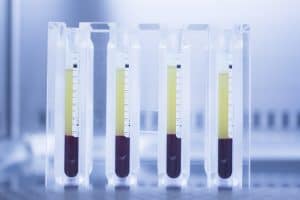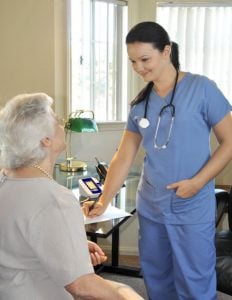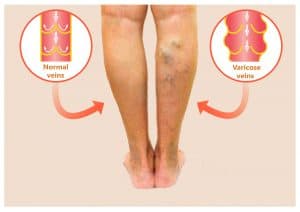- Recent study connects stem cell research and varicose vein treatments.

The treatment of stubborn vein disease has been revolutionized by newer treatments. These minimally-invasive procedures do very little collateral damage. Previously, vein stripping was the “gold standard” in the treatment of varicose veins. Most doctors of all types now agree that this is a terrible procedure, and today it’s rarely performed.
These newer, faster, safer procedures have in many cases made treatment worth pursuing in the first place. Before, the potential benefits simply weren’t worth the considerable risks—and downtime, and scarring. Suffering with unsightly, uncomfortable varicose veins was often a better option.
Yet these contemporary techniques are also continuously being improved upon. That’s modern medicine, and it’s helping people live longer, healthier, happier lives.
Stem cells, blood clots, and varicose veins are connected.
The Institute of Chemical Biology and Fundamental Medicine (ICBFM) is an international medical think-tank based in Siberia. There, scientists collaborate to study some of the most fundamental (and interesting) questions in medicine. In particular, they’re interested in why cells do exactly what they do. Medicine is more than surgery and prescription medications. It seeks to understand how the body and the cells within it becomes diseased, and how they get better. This is the type of basic, high-stakes question the organization seeks to answer.
First some basics. All blood flow begins in the heart. Blood then flows into the high-pressure arteries, where it’s then distributed to every cell in the body.
The veins then return this blood to the heart. Yet because the venous system is a lower-pressure system it’s possible for blood to stall.
Varicose veins occur in this way. The veins begin to fail, and blood begins to flow in the wrong direction—away from the heart. Blood pools in the legs which cause varicose veins. Modern vein procedures can address this quite efficiently.
Yet once this process takes hold another problem can occur. In veins like the ones just mentioned there is always a small yet present danger of blood clot formation. Thankfully, new research by the ICBFM suggests that stem cell therapy may be able to help.
How long does stem cell therapy take to start working?
Furthermore, there is no evidence to support the efficacy or safety of any stem cell therapy provided by stem cell clinics. Unapproved treatments are designed and carried out with limited monitoring, in contrast to FDA-approved procedures, which are subject to years of meticulous testing. The purported benefits of a stem cell therapy have never been the subject of a large-scale clinical investigation, despite the fact that stem cell clinics frequently feature positive customer reviews. The FDA has started to tighten laws and enforce them against these clinics in recent years.
We now know a lot more about the efficacy of blood stem cell transplants as a result of decades’ worth of research. We also realize that they are not quick fixes. Even while the actual process only takes a few hours, the recuperation period may span weeks. Patients are attentively watched by doctors and nurses throughout this time for adverse effects and signs of recovery.
How long is stem cell treatment effective?
In their advertisements, stem cell clinics make implausible claims of unproven treatment or even cures for everything from Parkinson’s disease to knee pain, frequently taking advantage of weak people who might feel as though they have nowhere else to turn. In truth, there is few data to support claims that any stem cell therapy is effective, much less provides long-lasting advantages.
Treatment Benefits of Stem Cell Therapy
Cardiovascular Disease
Heart tissue can become oxygen-deprived from cardiovascular disorders, leading to the production of scar tissue that affects blood pressure or blood flow. According to study, the production of multiple growth factors enables adult bone marrow stem cells to differentiate into the cells needed to repair the heart and blood arteries.
Promotes wound and incision healing
According to studies, stem cell therapy can assist promote the formation of new, healthy skin tissue, boost collagen synthesis, encourage the growth of hair following cuts or hair loss, and help replace scar tissue with freshly formed, healthy tissue.
How do stem cells help in wound healing and tissue repair?
Stem cells contribute to wound healing and tissue repair through several key mechanisms:
- Differentiation: Stem cells have the ability to differentiate into various cell types needed for tissue repair. For example, they can become skin cells, muscle cells, or bone cells, depending on the requirements of the damaged area.
- Secretion of Growth Factors: Stem cells release growth factors and cytokines that promote tissue repair and regeneration. These substances can stimulate the proliferation of nearby cells, enhance blood vessel formation (angiogenesis), and modulate the immune response to aid healing.
- Reduction of Inflammation: Stem cells can modulate the immune response and reduce inflammation, which is crucial for minimizing further tissue damage and creating an environment conducive to healing.
- Cell Homing: Stem cells can migrate to the site of injury or inflammation. They are attracted by signals from damaged tissues, which allows them to localize where they are most needed for repair.
Can stem cell therapy be used to enhance recovery from sports injuries?
Yes, stem cell therapy can be used to enhance recovery from sports injuries. It has shown promise in treating various musculoskeletal conditions commonly seen in athletes. Here’s how stem cell therapy can help with sports injuries:
- Accelerated Healing: Stem cells can promote faster healing by differentiating into the specific cell types needed for tissue repair, such as muscle, tendon, ligament, or cartilage cells.
- Reduction of Inflammation: Stem cells release anti-inflammatory cytokines that help reduce inflammation at the injury site, which can alleviate pain and speed up the healing process.
- Tissue Regeneration: Stem cells can aid in regenerating damaged tissues, whether it’s cartilage in joints, muscle fibers, or ligaments. This can lead to more complete and durable repairs compared to traditional treatments.
A vein treatment with no notable side effects.
Viable treatments are expected to be developed soon, and they’ll most likely have no side effects. It’s true that any treatment which breaks the skin carries some risk. When a solution of stem cells and other healing factors is injected into a diseased vein infection is possible. This injection wouldn’t have any higher risk than other injections, though.
“We’re injecting stem cells into the affected area,” continues the spokesperson. “They make lots of things happen. For instance, even if they don’t survive they encourage macrophage activity. This means that large digester-type cells come and gobble up damaged tissue. We think that this is part of what causes healing. We’re doing the research, publishing, and we’ve got a patent. It’s an exciting time for us.”
The next steps:
A central pillar of medical science is the “first do no harm” principle. All of your doctors—orthopedic surgeons, dentists, chiropractors, podiatrists—took an oath to act in your best interest, always. This means no guesswork on patients. Treatments which look promising must be proven effective through research.
According to the ICBFM, “a useful, targeted treatment is coming. We’re one of the groups doing the research which will make this possible. Will we win a Nobel Prize? Who knows. We believe that our ideas will be part of this treatment, though.”

Many patients are surprised to hear that major medical insurance plans insurance will often cover existing procedures. If you’ve had enough of your vein problems then it’s easy to take action. Call the Advanced Vein Center at (724) 987-3220 today and book your appointment. One of our safe, highly effective, and minimally invasive procedures can most likely help.
Stem cells have the potential to become any type of cell the body might need. Perhaps more importantly they contain and produce healing factors which can positively influence most forms of cellular healing. This includes the growth of new veins in response to vein disease. This could potentially save lives in the treatment of blood clots.
Scientists at the institute are actively researching the use of stem cells for this purpose. So far they’ve managed to aid in the growth of new vessels at the site of clotting events. The results are still experimental, however. An ICBFM spokesperson said “we’re preparing the area for natural blood vessel regeneration. Right now we’re using stem cells to stimulate growth. We’re getting encouraging results, and we’re part of ongoing research. We want to cause veins to regenerate rapidly after a clotting event like a DVT.”
Such treatments should play a major role in treating relatively severe vein conditions like ankle ulcers. By bypassing damaged veins, a proper blood supply can be re-established to the skin of the ankle. Possibly serious ankle ulcers can then heal normally, or better yet not form at all.

